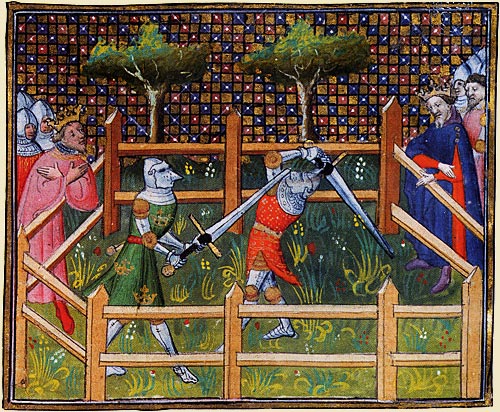The Tournaments of the 12th Century
Part II
In the early days of the tournament there were no rules to the ranks of men a lord might include in his companie. The accounts include tales of archers and men at arms defending their lords in some tournaments, or being used to truss a captive and haul him from the field, though this was changing by the end of the twelfth century. Nor were there limits to the number of men a lord might bring. The Count of Flanders is reputed to have brought 300 foot soldiers to one tournament, and young King Henry is said to have brought close to 100 Knights to another, with a number of them bringing their own mesnies.
Upon arrival at a tournament, it was not uncommon for the individual mesnies to join with others of their own countrymen, making a larger force, which would fight together under the command of the highest ranking noble of that land. In fact, many accounts mention individual Knights only by their country, rather than by whose company they rode in.
As early as the twelfth century, the tournament was a spectacle that a great many people would travel to attend. This was in no small part due to the leaders of the mesnies. They would sometimes hire troubadours to sing their praises, or heralds to lead them in the grand processions, and largess was often widely spread. And of course no large gathering was likely to occur without a fair surrounding it with games, vendors, and other merchants traveling in hopes of profiting from the gathering of wealthy patrons.
The fighting in the tournaments could last all day, and larger tournaments often lasted for several days. Some tournaments would begin with the joust, but these were not seen as the main event. Rather they were the opportunity for young unproven knights to demonstrate their valor and skill before the serious tournament began.
As was mentioned above, the fighting of the actual tournament would range across the countryside, often with only the vaguest of boundaries. With such a wide ranging action it might have been difficult to see much of the fighting.
There were rarely formal galleries as such (though young King Henry was said to have once called for a chair to be brought to him on a hilltop, “that he might watch the battle rage around him.”) but there were places that non-combatants could safely gather. These refuges were carefully defined areas where no combat could take place.
The refuge was a place where a knight would lead a prisoner to arrange a ransom, as well as where they could rest or re-arm. Heralds, troubadours, and occasionally even noble ladies would gather here as well, and time was sometimes spent in dance or song. One one occasion, the Marshal himself is even said to have sung the tune for a dance.
Since a knight might sit a while, mount his horse and join the fray for a time, then return to the refuge at will, this of course led to other uses of these safe zones. Much like a child in a game of tag, a knight, afraid of capture, might race for the refuge to avoid being taken and ransomed.
The Count of Flanders is said to have often used the refuge in another way. He would sit out the fierce action of the early charges at the beginning of a days fighting, and then once other knights began to tire, he would enter the field with advantage of being fresh and rested.
At the end of a day's fighting, the evenings would be spent in feast and revelry. At times, the hosts of the tournament would provide the feast, and at others individual lords would entertain their mesnies in their own camps. Prizes were sometimes awarded to men or entire companies who had impressed the judges – who were usually senior knights and heralds.
This was also the time when promised ransoms could be collected, and any grievances settled. A knight could call on the camp of someone he felt had wronged him and complain to his lord in search of redress. Though there were limited formal rules, the knights were perhaps more tightly bound by their own social customs of what were honorable actions.
For example, attacking an unaware or unprepared opponent, or an opponent who for some reason was unable to adequately defend themselves was often considered unfair. The chronicles contain multiple occasions where a Lord commands a knight of their mesnie to make amends for these dishonorable dealings, or face their displeasure. When William Marshal complained to a French noble of his nephew's unacceptable actions in taking a horse from him, the lord actually threatened to disown his relative and cast him from his house if the horse were not returned to the Marshal.
On these tournament fields, a man's prowess was important, but no less so a man's other virtues – for this was the beginning of what some might call the true age of chivalry.

